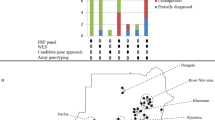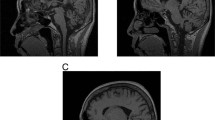Abstract
The autosomal dominant cerebellar ataxias (ADCA) are a group of neurodegenerative disorders characterized by onset with gait ataxia, dysarthria, dysmetria and dysdiadochokinesia. We have demonstrated previously genetic heterogeneity within these disorders by excluding the disease locus from the documented spinocerebellar ataxia locus (SCA1) on chromosome 6p in a large Cuban founder population. We now report the assignment of a second locus for ADCA (SCA2) to chromosome 12q23–24.1 following linkage analyses carried out for the Cuban pedigrees, with probable flanking markers D12S58 and phospholipase A2. Investigation of linkage to the interval containing SCA2 for seven French ADCA families, previously excluded from linkage to SCA1, provides preliminary data suggesting the existence of a third ADCA locus (SCA3).
This is a preview of subscription content, access via your institution
Access options
Subscribe to this journal
Receive 12 print issues and online access
$209.00 per year
only $17.42 per issue
Buy this article
- Purchase on SpringerLink
- Instant access to full article PDF
Prices may be subject to local taxes which are calculated during checkout
Similar content being viewed by others
References
Weatherall, D.J. The New Genetics and Clinical Practice (Oxford University Press, Oxford 1984).
Pogacar, S. et al. Dominant spino–pontine atrophy: Report of two additional members of the family W. Arch. Neurol. 35, 156–162 (1978).
Brown, S. On hereditary ataxy, with a series of twenty-one cases. Brain 15, 250–268 (1982).
Konigsmark, B.W. & Lipton, H.L. Dominant olivo–ponto–cerebellar atrophy with extrapyramidal signs. Report of a family through three generations. Birth Defects Orig. Art. Ser. 1, 178–191 (1971).
Weiner, L.P., Konigsmark, B.W., Stoll, J. Jr. & Magladery, J.W. Hereditary olivo–ponto–cerebellar atrophy with retinal degeneration. Report of a family through six generations. Arch. Neurol. 16, 364–376 (1967).
Collins, F.S. Positional cloning: Let's not call it reverse anymore. Nature Genet. 1, 3–6 (1992).
Yakura, H., Wakisaka, A., Fujimotos, S. & Itakura, K. Hereditary ataxia and HLA genotypes. New Engl. J. Med. 291, 154–155 (1974).
Jackson, J.F., Currier, R.D., Terasaki, P.I. & Morton, N.E. Spinocerebellar ataxia and HLA linkage: Risk prediction by HLA typing. New Engl. J. Med. 296, 1138–1141 (1977).
Litt, M. & Luty, J.A. Dinucleotide polymorphism at the D6S89 locus. Nucl. Acids Res. 18, 4301 (1990).
Ranum, L., Chung, M.Y., Duvick, L.A., Zoghbi, H.Y. & Orr, H.T. Dinucleotide repeat polymorphism at the D6S109 locus. Nucl. Acids Res. 19, 1171 (1991).
Orozco, G., Nodarse, A., Cordoves, R. & Auburger, G. Autosomal dominant cerebellar ataxia: Clinical analysis of 263 patients from a homogeneous population in Holguin, Cuba. Neurology 40, 1369–1375 (1990).
Auburger, G. et al. Autosomal dominant ataxia: Genetic evidence for locus heterogeneity from a Cuban founder effect population. Am. J. hum. Genet. 46, 1163–1177 (1990).
Keats, B.J.B. et al. Guidelines for human linkage maps: An international system for human linkage maps (ISLM, 1990). Genomics 9, 557–560 (1991).
Hoppener, J.W. et al. The human gene encoding insulin–like growth factor I is located on chromosome 12. Hum. Genet. 69, 157–160 (1985).
Weber, J.L., Kwitek, A.E., May, P.E., Wilkie, P.J. & Decker, R.A. In Human Gene Mapping 11. Report of the committee on the genetic constitution of chromosome 12. Cytogenet. cell Genet. 58, 555–579 [A26934] (1991).
Romanul, F.C.A., Fowler, H.L., Radvany, J., Feldman, R.G. & Feingold, M. Azorean disease of the nervous system. New Engl. J. Med. 296, 1505–1508 (1977).
Coutinho, P. & Andrade, C. Autosomal dominant system degeneration in Portuguese families of the Azores Islands: A new genetic disorder involving cerebellar, pyramidal, extrapyramidal and spinal cord motor functions. Neurol. 28, 703–709 (1978).
Gispert, S., Nothers, C., Orozco, G. & Auburger, G. Search of the chromosome locus of autosomal dominant cerebellar ataxia from Holguin, Cuba: Exclusion from candidate regions on chromosome 4 and 11q. Hum. Heredity 43, 12–30 (1993).
Khati, C. et al. Genetic heterogeneity of autosomal dominant cerebellar ataxia type 1. Clinical and genetic analysis of 10 French families. Neurology (in the press).
Weber, J.L. & May, P.E. Abundant class of human DNA polymorphisms which can be typed using the polymerase chain reaction. Am. J. hum. Genet. 44, 388–396 (1989).
Lathrop, G.M., Lalouel, J.M., Julier, C. & Ott, J. Strategies for multilocus linkage analysis in humans. Proc. natn. Acad. Sci. U.S.A. 81, 3443–3446 (1984).
Ott, J. Genetic linkage studies in man. Transplant. Proc. XI, 1689–91 (1979).
Polymeropoulos, M.H., Rath, D.S., Xiao, H. & Merril, C.R. Trinucleotide repeat polymorphism at the human pancreatic phospholipase A-2 gene (PLA2). Nucl. Acids Res. 18, 7468 (1990).
Author information
Authors and Affiliations
Rights and permissions
About this article
Cite this article
Gispert, S., Twells, R., Orozco, G. et al. Chromosomal assignment of the second locus for autosomal dominant cerebellar ataxia (SCA2) to chromosome 12q23–24.1. Nat Genet 4, 295–299 (1993). https://doi.org/10.1038/ng0793-295
Received:
Accepted:
Issue Date:
DOI: https://doi.org/10.1038/ng0793-295



